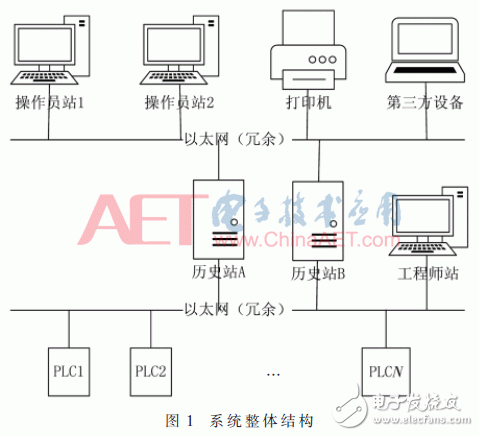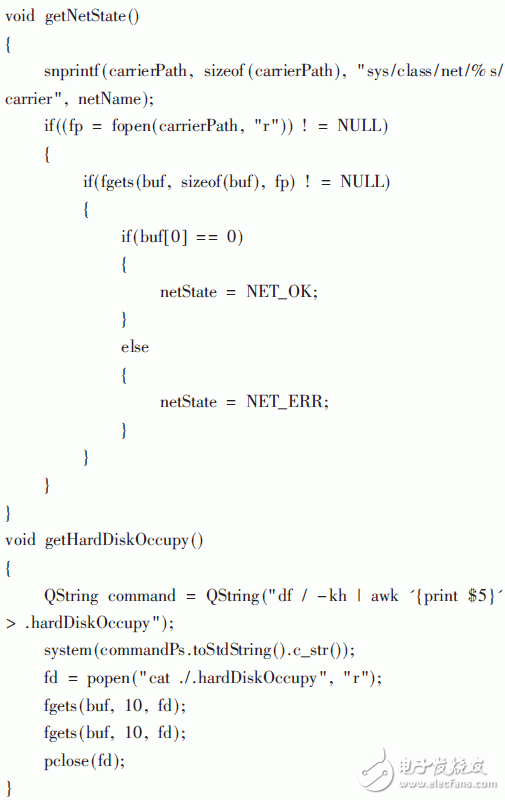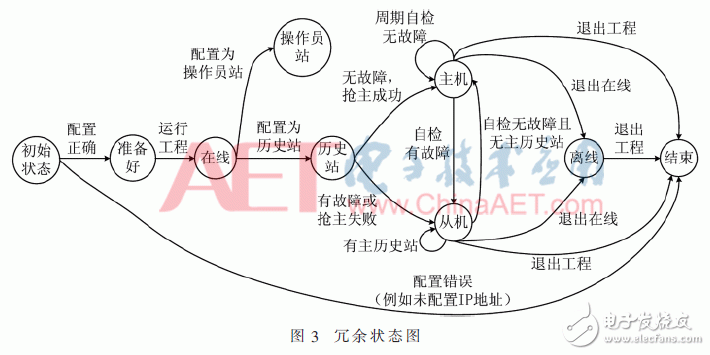Most of the existing data acquisition and monitoring control (SCADA) systems run on the Windows platform, lacking localization considerations [1]. The SCADA system development and operation environment described in this paper has achieved national production. As an industrial-grade data acquisition and monitoring control software, it requires high stability and reliability of the system. Therefore, a stateful diagnostic subsystem is required in the SCADA system, and the key component of the system, the server, must be redundantly configured. When the primary server fails, it can diagnose the fault in time and switch to the backup server, and the switching process cannot cause disturbance. . Because the state diagnosis system is closely related to the operating system, the implementation under different operating systems may be very different. This paper designs and implements a self-developed state diagnosis system based on the domestic Kirin operating system.
1 overall structureThe data acquisition and monitoring control system adopts cross-platform software architecture design: the hardware adopts the domestic Feiteng processor server and desktop (or notebook), the operating system adopts the domestically-winned unicorn, the development tool adopts cross-platform Qt, and supports the domestically-winning bid. Cross-platform runs on Kirin and Windows operating systems. The overall structure of the system is shown in Figure 1.

The data acquisition and monitoring control system adopts the client/server architecture. Under normal circumstances, the historical station is the server of the system. If the user has high reliability requirements, the redundant historical station will be configured, and the historical station is responsible for data interaction with the lower computer. And record historical data. The client is the individual operator station, the data of the operator station is obtained from the historical station, and the network only transmits the change data set that changes in each second. The operator station is used for human-computer interaction, displaying the status of the site with text and animation, and can operate the switches and valves on site. According to the needs of users, you can configure the external communication function to release the data and status of the management user's concern through the network [2].
2 functions and implementationThe data acquisition and monitoring control system is functionally divided into offline function and online function: offline includes engineering configuration, offline query, etc. Online includes data communication, service processing, data processing, screen monitoring, etc. [3]. The functions of the operator station and the historical station are different. The operator station mainly includes the graphic interface of the screen monitoring, data delivery, printing, etc., and the historical station contains all the functions of the operator station, and also includes data communication and service. Background tasks such as processing and data processing. Status diagnostics are background service subsystems that both operator and historical stations have. The software structure is shown in Figure 2.

The historical station contains all the functions of the design advantage, for a small project, you can configure only one historical station, or configure two redundant historical stations, which can effectively reduce costs.
2.1 Basic function of the status diagnosis subsystem(1) Initially determine the master-slave state of the historical station: the host is started first; at the same time, the historical station of A is the host.
(2) Periodic self-diagnosis: Periodically diagnose the status of each subtask of the machine and the status of system resources.
(3) Periodic mutual diagnosis: the heartbeat monitoring between the master and the slave is realized, and the heartbeat value is periodically transmitted through each other. When the host does not receive the heartbeat signal of the slave, it still works normally. If the slave does not receive the heartbeat signal of the host, it will switch to the host.
(4) Determine the status of the data station:
1 Online: task management, data communication, server status diagnosis, school time, data processing, historical data collection, data collection, alarm, full record, etc., all running normally.
2 Offline: Except for the data communication module, the tasks that need to be online are not running.
3 Fault: There is an abnormal operation of the online task when online [4].
2.2 Self-diagnosis modeThe state of each subtask is detected by periodically detecting the heartbeat value. For a subtask with a heartbeat timeout, you can configure the task to not shut down, restart, shut down, restart, and restart. If the subtask still fails to run normally, the slave only reports the fault and the host needs to Switch to slave.
The winning kylin system can obtain system resource status in two ways:
(1) Read the system file, for example, by reading the carrier file to obtain the network status. For some sample code, see the function void getNetState().
(2) Call the shell command to parse the return value of the command. For example, you can obtain the hard disk usage rate by parsing the execution result of the df command. For some sample code, see the function void getHardDiskOccupy().

For the double-master problem that most redundant historical stations are prone to occur, this paper has produced a detailed redundant switching table, which proves that the emergence of dual masters can be avoided. Partial redundancy switching is shown in Table 1.

In order to ensure stable and reliable operation of the system, SCADA's state diagnostic system needs to determine the current state of the system and determine when the conditions for state switching are met. The state diagnosis system designed and implemented in this paper performs state judgment and switching according to the state diagram shown in Figure 3 [5].

The status diagnosis system needs to check whether the project configuration is correct before the project is run. If the configuration is incorrect (if the historical station is not configured and the PC name is incorrectly configured), an error is displayed and the project is terminated; if the configuration is correct, each subtask is started, and Run the project.
After running the project, it enters the online state and detects the local configuration. If it is configured as an operator station, there is no difference between the master and the slave, and it runs in the state of the operator station until it exits online or exits the project; if it is configured as a historical station, It is necessary to judge the master-slave state, and determine the master-slave state according to the principle that the fault does not preempt the master and the A-machine priority.
In order to reduce the number of handovers, the host will remain in the master state without failure, and the slave slave will detect the state of the master. If the master drops or exits, the slave self-test can be upgraded without failure.
Both the master and the slave can log out of the line or exit the project.
3 Experimental resultsExperimental conditions: Historical station A and historical station B are all operating normally. The experimental operation and experimental results are shown in Table 2.

The experimental results show that the system can operate stably on the domestic Kirin system according to the expected results. By monitoring the task, forcibly closing and restarting the task, the faulty subtask can be processed in time to ensure the normal operation of each subtask; through the server redundancy configuration, the main historical station failure can be quickly switched to the historical station. So that the failure of the historical station does not affect the normal operation of the main historical station.
A manual pulse generator (MPG) is a device normally associated with computer numerically controlled machinery or other devices involved in positioning. It usually consists of a rotating knob that generates electrical pulses that are sent to an equipment controller. The controller will then move the piece of equipment a predetermined distance for each pulse.
The CNC handheld controller MPG Pendant with x1, x10, x100 selectable. It is equipped with our popular machined MPG unit, 4,5,6 axis and scale selector, emergency stop and reset button.
Manual Pulse Generator,Handwheel MPG CNC,Electric Pulse Generator,Signal Pulse Generator
Jilin Lander Intelligent Technology Co., Ltd , https://www.jllandertech.com